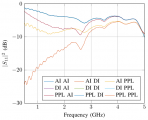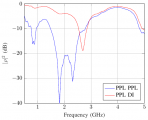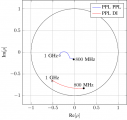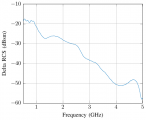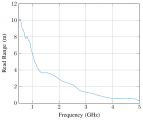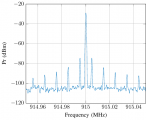Difference between revisions of "PX505 Innovation Project"
| (12 intermediate revisions by the same user not shown) | |||
| Line 1: | Line 1: | ||
== Backscattering Using Classical MCU == | == Simple Low Cost RFID Reader (2015/16)== | ||
=== Students === | |||
* Carlos De Andrade Reverbel | |||
* Raymundo De Amorim Junior | |||
* Caroline Gaillard | |||
=== Subject === | |||
The objective of this project was to reproduce the work initiated in <ref> P. V. Nikitin, S. Ramamurthy, and R. Martinez, “Simple Low Sost UHF | |||
RFID Reader,” in 2013 IEEE International Conference on RFID (RFID), Orlando, FL, USA, Apr. 2013, pp. 1–2.</ref>. This reader design is based on | |||
a simple envelope detector and provide the simplest architecture to read a UHF tag. | |||
=== Results === | |||
More than five years after this initial work, a conference article has been accepted <ref>N. Barbot, R. De Amorim Junior and P. Nikitin, [https://nicolas-barbot.ovh/wiki/pool/RFID_shortv3.pdf “Simple Low Cost Open Source UHF RFID Reader,”] in 2022 IEEE RFID Conference (IEEE RFID 2022), Las Vegas, Nevada, May 2022, pp. 1–1. '''Best Poster Award'''</ref>. Note that this paper does not appears in the proceedings since was included in the poster session and is present here for information purpose only. A long version have also been published <ref>N. Barbot, R. De Amorim Junior and P. Nikitin, [https://nicolas-barbot.ovh/wiki/pool/reader.pdf “Simple Low Cost Open Source UHF RFID Reader,”] in Journal of Radio Frequency Identification, accepted</ref>. More information about this project is available on [[Simple Low Cost Open Source UHF RFID Reader]]. | |||
== Backscattering Using Classical MCU (2020/21)== | |||
=== Students === | === Students === | ||
| Line 19: | Line 40: | ||
=== Results === | === Results === | ||
<gallery widths= | <gallery widths=230px> | ||
File:Figure0-1.png|Fig. 1: S11 measured at the VNA for different GPIO modes of a PIC16. | File:Figure0-1.png|Fig. 1: S11 measured at the VNA for different GPIO modes of a PIC16. | ||
File: | File:Figure2-1.png|Fig. 2: <math>|\rho|^2</math> for a dipole antenna in the 2 different states. | ||
File: | File:Figure3-1.png|Fig. 3: Polar representation of <math>\rho</math> in the 2 different states. | ||
File: | File:Figure4-1.png|Fig. 4: Delta RCS as a function of the frequency. | ||
File: | File:Figure5-1.png|Fig. 5: Read range as a function of the frequency. | ||
File: | File:Figure6-1.png|Fig. 6: Modulated signal observed at the spectrum analyzer. | ||
</gallery> | </gallery> | ||
A conference article has also been published using the developed prototype <ref>A. Voisin, A. Dumas, N. Barbot and S. Tedjini, [https://nicolas-barbot.ovh/wiki/pool/nstate2.pdf “Differential RCS of Multi-State Transponder,”] 2022 IEEE Wireless Power Week Conference (WPW 2022), Bordeaux, France, Jul. 2022, pp. 1–4.</ref>. | |||
==References== | |||
Latest revision as of 12:39, 7 December 2022
Simple Low Cost RFID Reader (2015/16)
Students
- Carlos De Andrade Reverbel
- Raymundo De Amorim Junior
- Caroline Gaillard
Subject
The objective of this project was to reproduce the work initiated in [1]. This reader design is based on a simple envelope detector and provide the simplest architecture to read a UHF tag.
Results
More than five years after this initial work, a conference article has been accepted [2]. Note that this paper does not appears in the proceedings since was included in the poster session and is present here for information purpose only. A long version have also been published [3]. More information about this project is available on Simple Low Cost Open Source UHF RFID Reader.
Backscattering Using Classical MCU (2020/21)
Students
- Anton Dumas
- Alexandre De Carlo
- Arnaud Voisin
- Bastien Lemaire
Subject
Backscattering Communications Using Classical Micro-Controller is a project based on the compelling idea proposed by [4] where a transmission can be done without using any RF chip. By modifying the internal state of GPIOs connected to an antenna, it is possible to modulate the backscattered signal of a remote reader. This technique allows to reduce the number of component of the system and decrease the power consumption.
This modulated power can be linked to the delta RCS introduced in [5] which allows to extract read range of the system.
Results
A conference article has also been published using the developed prototype [6].
References
- ↑ P. V. Nikitin, S. Ramamurthy, and R. Martinez, “Simple Low Sost UHF RFID Reader,” in 2013 IEEE International Conference on RFID (RFID), Orlando, FL, USA, Apr. 2013, pp. 1–2.
- ↑ N. Barbot, R. De Amorim Junior and P. Nikitin, “Simple Low Cost Open Source UHF RFID Reader,” in 2022 IEEE RFID Conference (IEEE RFID 2022), Las Vegas, Nevada, May 2022, pp. 1–1. Best Poster Award
- ↑ N. Barbot, R. De Amorim Junior and P. Nikitin, “Simple Low Cost Open Source UHF RFID Reader,” in Journal of Radio Frequency Identification, accepted
- ↑ A. Dadkhah, J. Rosenthal and M. S. Reynolds, "ZeroScatter: Zero-Added-Component Backscatter Communication Using Existing Digital I/O Pins," 2019 IEEE Topical Conference on Wireless Sensors and Sensor Networks (WiSNet), Orlando, FL, USA, 2019, pp. 1-3
- ↑ P. V. Nikitin, K. V. S. Rao, and R. D. Martinez, “Differential RCS of RFID tag,” Electronics Letters, vol. 43, no. 8, pp. 431–432, Apr. 2007.
- ↑ A. Voisin, A. Dumas, N. Barbot and S. Tedjini, “Differential RCS of Multi-State Transponder,” 2022 IEEE Wireless Power Week Conference (WPW 2022), Bordeaux, France, Jul. 2022, pp. 1–4.

